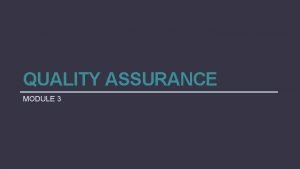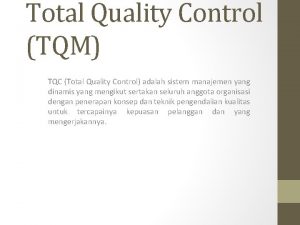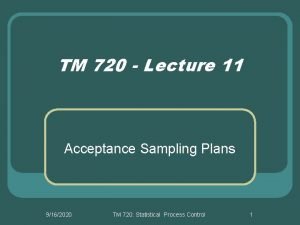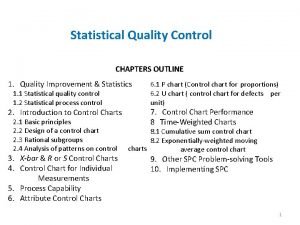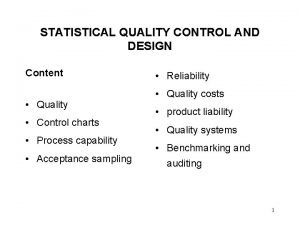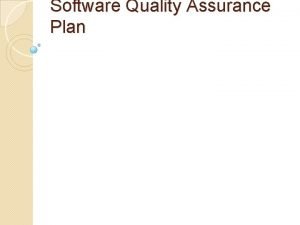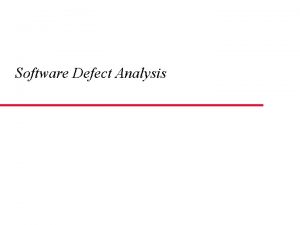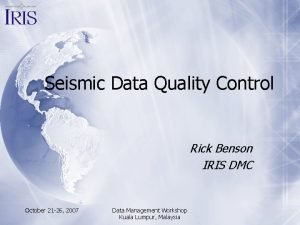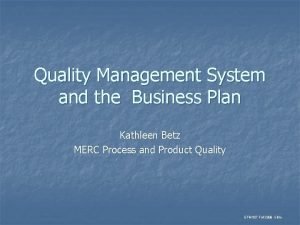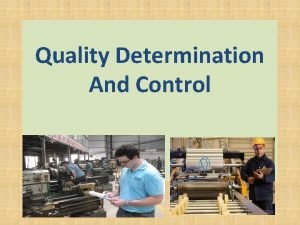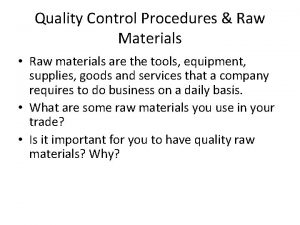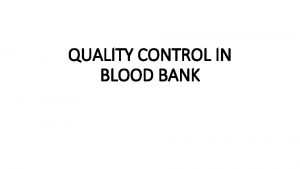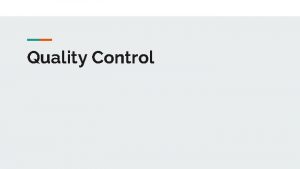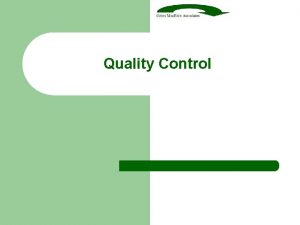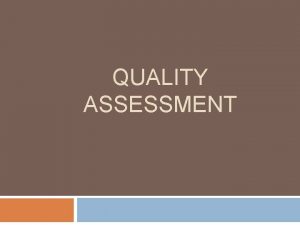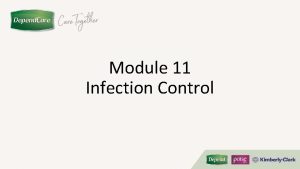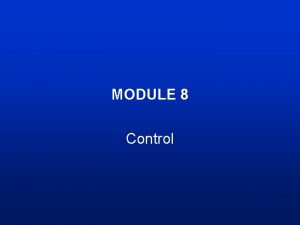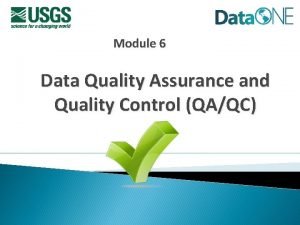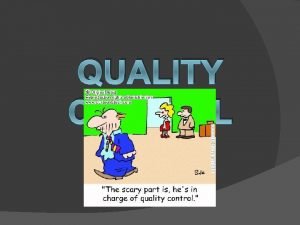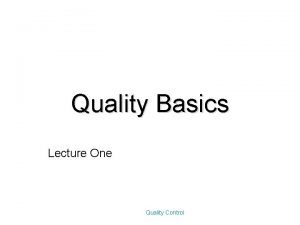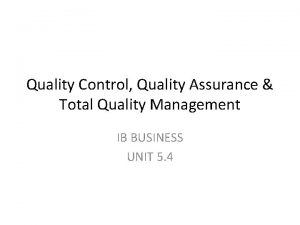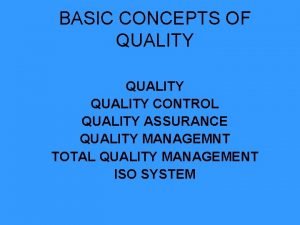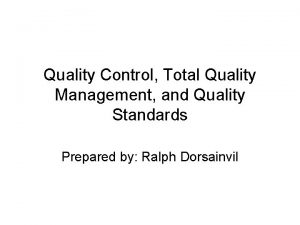Module 11 Quality Control 1 Quality Control QC























- Slides: 23

Module 11 Quality Control 1

Quality Control (QC) • Control – the activity of ensuring conformance to requirements and taking corrective action when necessary to correct problems • Importance – Daily management of processes – Prerequisite to longer-term improvements 2

Designing the QC System • Quality Policy and Quality Manual – – Contract management, design control and purchasing Process control, inspection and testing Corrective action and continual improvement Controlling inspection, measuring and test equipment (metrology, measurement system analysis and calibration) – Records, documentation and audits Hinckley, C. (1997). Defining the best quality-control systems by design and inspection. Clinical Chemistry. Vol. 43(5) 873 -879. 3

Inspection/Testing Points • Receiving inspection • In-process inspection • Final inspection 4

Receiving Inspection • Spot check procedures • 100 percent inspection • Acceptance sampling • Exercise: – Pens & Paper clips 5

Why not 100% Inspection? Problems with 100% inspection • Very expensive • Can’t use when product must be destroyed to test • Handling by inspectors can induce defects • Inspection must be very tedious so defective items do not slip through inspection 6

A Lot-by-lot Sampling Plan • Specify the plan (n, c) given N • For a lot size N, determine the sample size n, and the acceptance number c. • Reject lot if number of defects > c • Specify course of action if lot is rejected 7

Pros and Cons of Acceptance Sampling • Arguments for: – Provides an assessment of risk – Inexpensive and suited for destructive testing – Requires less time than other approaches – Requires less handling – Reduces inspector fatigue • Arguments against: – Does not make sense for stable processes – Only detects poor quality; does not help to prevent it – Is non-value-added – Does not help suppliers improve – Type I Error 8

In-Process Inspection • What to inspect? – Key quality characteristics that are related to cost or quality (customer requirements) • Where to inspect? – Key processes, especially high-cost and valueadded • How much to inspect? – All, nothing, or a sample 9

Human Factors in Inspection • • complexity defect rate repeated inspections inspection rate *Inspection should never be a means of assuring quality. The purpose of inspection should be to gather information to understand improve the processes that produce products and services. 10

Gauges and Measuring Instruments • Variable gauges (Provides deviation level) • Fixed gauges (Provides measurement level) • Coordinate measuring machine (Physical geometric characteristics) • Vision systems (High-speed imagery, selfcontained) 11

Examples of Gauges 12

Metrology - Science of Measurement • Accuracy - closeness of agreement between an observed value and a standard • Precision - closeness of agreement between randomly selected individual measurements 13

Repeatability and Reproducibility • Repeatability (equipment variation) – variation in multiple measurements by an individual using the same instrument. • Reproducibility (operator variation) variation in the same measuring instrument used by different individuals 14

Repeatability and Reproducibility Studies • Quantify and evaluate the capability of a measurement system – Select m operators and n parts – Calibrate the measuring instrument – Randomly measure each part by each operator for r trials – Compute key statistics to quantify repeatability and reproducibility 15

16

Range Measurement for each Sample: Average Measurement for each Operator: Average Difference: Average Range for each Operator: Overall Range: Where: n = #of samples, r = #of trials, m = #of operators; i = operator, j = sample, k = trial 17

Equipment Variation (EV): Operator Variation (OV): Repeatability and Reproducibility (R&R): 18

R&R Evaluation • Under 10% error - OK • 10 -30% error - may be OK • over 30% error - unacceptable 19

Debriefing What happened in the first experiment? (Rubber band length) …and the second? What could be done to improve the measurement process? …and the analysis process? 20

Calibration • Calibration - comparing a measurement device or system to one having a known relationship to national standards • Traceability to national standards maintained by NIST, National Institute of Standards and Technology (e. g. atomic clock) https: //www. youtube. com/watch? v=z-j. E 7 DXy 1 x 0#t=268 21

Example of QC: HACCP System 1. Hazard analysis 2. Critical control points 3. Preventive measures with critical limits for each control point 4. Procedures to monitor the critical control points 5. Corrective actions when critical limits are not met 6. Verification procedures 7. Effective record keeping and documentation 22

Quality Control in Services • Identify important quality characteristics – Time, errors, behavior • Measure and collect data using check sheets, check lists, or other means • Take corrective action 23
 Quality control module
Quality control module Perform quality assurance
Perform quality assurance Quality control vs quality assurance pmp
Quality control vs quality assurance pmp Pmp gold plating
Pmp gold plating Basic concept of quality management
Basic concept of quality management C device module module 1
C device module module 1 Quality assurance model in nursing
Quality assurance model in nursing Compliance vs quality
Compliance vs quality David a garvin 8 dimensions of quality
David a garvin 8 dimensions of quality Quality is free: the art of making quality certain
Quality is free: the art of making quality certain What is tqm
What is tqm Mémoire inspe
Mémoire inspe Tqm tqc
Tqm tqc Producer's risk
Producer's risk Average run length in quality control
Average run length in quality control Explain statistical quality control
Explain statistical quality control Software quality assurance planning
Software quality assurance planning Quality control log examples
Quality control log examples Quality control shanghai
Quality control shanghai Rick benson iris
Rick benson iris Quality control in business plan
Quality control in business plan Control determination
Control determination Receiving raw materials
Receiving raw materials Whole blood quality control
Whole blood quality control
